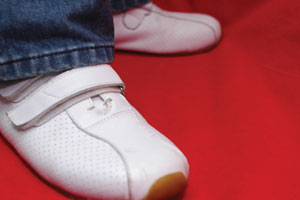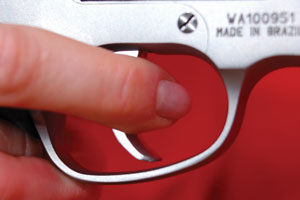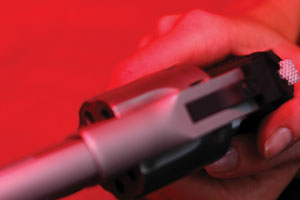Coaching tips
by Ric Tester
 Feet placement
Feet placement
The stance is the supporting framework that determines how stable the
body and shooting arm will be during a course of fire. Feet should be
placed apart at approximately shoulder width, with the toes further
apart from each other than the heels. This will create a
‘trapezoid’-type support area that will be both comfortable and stable.
Each leg should support 50 per cent of the body weight and the load on
each foot should be centred just behind the ball of the foot.
Grip
A good grip will always facilitate good sight alignment. If your grip
is correct, the sights will quickly realign themselves on the target
after firing without the need for major adjustment. Rapid- and
timed-fire events are dependent upon fast target acquisition and
recovery after recoil. A correct grip will cause the gun to recoil with
a gentle rearward push to the hand, which should almost automatically
spring back into the ready-to-fire position.
Head
Keep your head still while shooting. Your eyes need to be on the same
imaginary line that travels between gun and target. Head movement - and
especially the habit of cocking the head sideways when sighting - is a
bad habit that is easy to pick up but hard to shake.
 Trigger technique
Trigger technique
The trigger finger must be trained to act independently from the
middle, third and little finger. It should not even touch the frame of
the gun. It should be drawn back gently and continuously while the sight picture is being
held. Note that gently does not necessarily mean slowly. Actuating the
trigger too slowly will allow time for fatigue and pistol movement to
set in.
Breath control
Normal breathing causes movement of the whole body. The breath is held
during shooting by allowing the breath to exit the body and remaining
in a period of relaxation for a slightly extended period before
inhaling the next breath. During a course of timed fire you may have to
hold your breath for as long as 15 or 20 seconds. This is perfectly
achievable with a little practice.
The conscious and unconscious
As we develop any skill, it becomes more deeply embedded in our
subconscious mind and becomes automatic. Stance, grip, sight alignment
and trigger pull should, and will, become automatic with effort and
practice. This frees up the mind for the conscious action of holding
the gun on target. Also remember that concentration and relaxation go
hand in hand - ie, the more relaxed you are, the more you can
concentrate and ‘get it all together’.
Rehearse your competitions
Your training sessions should be divided into two broad categories -
skill development and match practice. A match practice session should
be executed in a manner and fashion that simulates, as closely as
possible, a real contest. When you are used to a routine you will be
less likely to be thrown by an event. Make every competition like just
another practice session.
 Analyse your shooting
Analyse your shooting
Mindless firing of ammunition is a fruitless endeavour. Always look at
your results and make an honest analysis of the group and the factors
that led up to it. If results are good, try to duplicate the actions
that worked; if things went poorly, make a change and try again. The
change may need to be made as a result of the advice of a supportive
observer or a coach, as sometimes our powers of observation are least
acute when gazing into a mirror!
The checklist
When you are analysing your own shooting, ask yourself these questions:
- what was I looking at the moment the shot broke?
- was the gun in its minimum arc of movement when the shot broke?
- did the shot truly break unexpectedly - as a surprise?
- did I flinch?
- did I follow through correctly?
